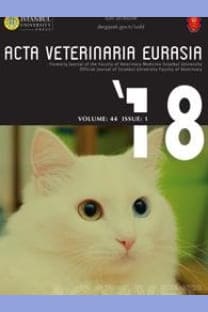Bioequivalence Study of Two Different Formulations of Ceftiofur Following Intramuscular Administration in Cattle
Bioequivalence Study of Two Different Formulations of Ceftiofur Following Intramuscular Administration in Cattle
___
- Al-Kheraije, K. A. (2013). Studies on the antibacterial activity of ceftiofur sodium in vitro and birds. Open Journal of Veterinary Medicine, 03(1), 16–21. [CrossRef]
- Altan, F., Uney, K., Er, A., Cetin, G., Dik, B., Yazar, E., & Elmas, M. (2017). Pharmacokinetics of ceftiofur in healthy and lipopolysaccharide-induced endotoxemic newborn calves treated with single and combined therapy. Journal of Veterinary Medical Science, 79(7), 1245–1252. [CrossRef]
- Brown, S. A., Chester, S. T., Speedy, A. K., Hubbard, V. L., Callahan, J. K., Hamlow, P. J., Hibbard, B., & Robb, E. J. (2000). Comparison of plasma pharmacokinetics and bioequivalence of ceftiofur sodium in cattle after a single intramuscular or subcutaneous injection. Journal of Veterinary Pharmacology and Therapeutics, 23(5), 273–280. [CrossRef]
- Cameron, A., Mantel-Teeuwisse, A. K., Leufkens, H. G. M., & Laing, R. O. (2012). Switching from originator brand medicines to generic equivalents in selected developing countries: How much could be saved? Value in Health , 15(5), 664 – 673. [CrossRef]
- Cetin, M., & Arıcıoğlu, F. (2009). On the debate of original drug versus generic drug. Bulletin of Clinical Psychopharmacology, 19, 211–213.
- De Baere, S., Pille, F., Croubels, S., Ceelen, L., & De Backer, P. (2004). High-performance liquid chromatographic-UV detection analysis of ceftiofur and its active metabolite desfuroylceftiofur in horse plasma and synovial fluid after regional intravenous perfusion and systemic intravenous injection of ceftiofur sodium. Analytica Chimica Acta, 512(1), 75–84. [CrossRef]
- El-Gendy, A. A. M., Tohamy, M. A., & Ismail, M. (2007). Comparative pharmacokinetics and renal clearance study of ceftiour in cross breed Friesian and Buffalo calves. Beni-Suef Veterinary Medical Journal, 17(1), 69–77.
- European Medicines Agency (EMA). (2011). Retrieved from http://www.ema. europa.eu/docs/en_GB/document_library/Scientific_guide - line/2011/04/WC500105372.pdf.
- European Generic Medicines Association (EGMA). (2010). Retrieved from https://www.medicinesforeurope.com/wp-content/uploads/2016/03/ EGA_BEQ_QA_WEB_QA_1_32.pdf.
- Gupta, P. K. (2018). Illustrated toxicology: With study questions (pp. 67–106). Cambridge: Academic Press.
- Hornish, R. E., & Kotarski, S. F. (2002). Cephalosporins in veterinary medicine – Ceftiofur use in food animals. Current Topics in Medicinal Chemistry, 2(7), 717–731. [CrossRef]
- Jacobson, G. A., Martinod, S., & Cunningham, C. P. (2006). Determination of ceftiofur in bovine plasma by HPLC-DAD. Journal of Pharmaceutical and Biomedical Analysis, 40(5), 1249–1252. [CrossRef]
- Kausche, F. M., & Robb, E. J. (2003). A comprehensive review of ceftiofur sodium and hydrochloride formulations for treatment of acute bovine foot rot. Veterinary Therapeutics : Research in Applied Veterinary Medicine, 4(1), 83–93.
- Lei, Z., Liu, Q., Yang, B., Ahmed, S., Xiong, J., Song, T., Chen, P., Cao, J., & He, Q. (2017). Evaluation of bioequivalence of two long-acting 20% oxytetracycline formulations in pigs. Frontiers in Veterinary Science, 4, 61. [CrossRef]
- Masich, A. M., Heavner, M. S., Gonzales, J. P., & Claeys, K. C. (2018). Pharmacokinetic/pharmacodynamic considerations of beta-lactam antibiotics in adult critically ill patients. Current Infectious Disease Reports, 20(5), 9. [CrossRef]
- Mestorino, N., Marchetti, M. L., Lucas, M. F., Modamio, P., Zeinsteger, P., Fernández Lastra, C. F., Segarra, I., & Mariño, E. L. (2016). Bioequivalence study of two long-acting formulations of oxytetracycline following intramuscular administration in bovines. Frontiers in Veterinary Science, 3, 50. [CrossRef]
- Ozawa, S., Evans, D. R., Bessias, S., Haynie, D. G., Yemeke, T. T., Laing, S. K., & Herrington, J. E. (2018). Prevalence and estimated economic burden of substandard and falsified medicines in low- and middle-income countries: A systematic review and meta-analysis. JAMA Network Open, 1(4), e181662. [CrossRef]
- Palermo-Neto, J., & Righi, D. A. (2008). Bioequivalence studies: Relevance for veterinary medicine. Brazilian Journal of Veterinary Research and Animal Science, 45, 5–19. [CrossRef]
- Peng, M., Salaheen, S., & Biswas, D. (2014). Animal health: Global antibiotic issues. Encyclopedia of Agriculture and Food Systems, 346–357. [CrossRef]
- Rita, B., & Akhilesh, T. (2015). Importance of bioequivalence studies for enhancing pharmacokinetic parameters. Research and Reviews: Journal of Pharmaceutics and Nanotechnology, 3, 89–96.
- Schall, R., & Endrenyi, L. (2010). Bioequivalence: Tried and tested. Cardiovascular Journal of Africa, 21(2), 69–71.
- Toutain, P. L., & Koritz, G. D. (1997). Veterinary drug bioequivalence determination. Journal of Veterinary Pharmacology and Therapeutics, 20(2), 79–90. [CrossRef]
- United States Food and Drug Administration (FDA). (2003). Retrieved from http://www.fda.gov/eder/guidance/3_61_5fnl.pdf.
- Vetchý, D., Frýbortová, K., Rabisková, M., & Danecková, H. (2007). Bioequivalence studies of pharmaceutical preparations. Casopis Lekaru Ceskych, 146(5), 431–433.
- Wang, J., Peng, H., Kong, J., Zhao, T., Zhang, S., & Cao, X. (2018). Pharmacokinetic profile of ceftiofur hydrochloride injection in lactating Holstein dairy cows. Journal of Veterinary Pharmacology and Therapeutics, 41(2), 301–306. [CrossRef]
- Xiong, J., Zhu, Q., Lei, Z., Yang, S., Chen, P., Zhao, Y., Cao, J., & Qiu, Y. (2018). Bioequivalence evaluation of two 5% ceftiofur hydrochloride sterile suspension in pigs. Journal of Veterinary Medical Science, 80(12), 1847–1852. [CrossRef]
- ISSN: 2618-639X
- Yayın Aralığı: 3
- Başlangıç: 1975
- Yayıncı: İstanbul Üniversitesi-Cerrahpaşa
Gülay YÜZBAŞIOĞLU ÖZTÜRK, Hazal ÖZTÜRK GÜRGEN, Aydın GÜREL, Pembe Dilara KEÇİCİ
Proximate Composition of Leg Meat of Slow and Fast-Growing Broiler in Different Housing Systems
Enver ÇAVUŞOĞLU, Metin PETEK, Ece ÇETİN, İsmail ÇETİN, Melahat ÖZBEK
Gastric Signet-Ring Cell Adenocarcinoma in a Dog
Mehmet Fatih BOZKURT, Fatma CANSIZ
Volodymyr HLEBENIUK, Natalia ALEKSEEVA, Olena HAVRYLINA, Maryna BILAN, Oleksiy TKACHENKO, Natalia KOZAK
Faruk TANDIR, Sabina ŠERIĆ-HARAČIĆ, Lejla VELIĆ, Benjamin ČENGIĆ, Nejra HADŽIMUSIĆ, Ermin ŠALJIĆ
How Do We Use Molecular Knowledge in Diagnosis and Control of Pandemic Avian Viruses?
Fethiye ÇÖVEN, Kamil Tayfun ÇARLI, Özge ARDIÇLI, Serpil KAHYA DEMİRBİLEK
Majid Gholami AHANGARAN, Paniz ZINSAZ, Oveys POURMAHDI, Asiye AHMADI-DASTGERDI, Mehrdad OSTADPOUR, Mahsa SOLTANI
Tülay BAKIREL, Ali Haydar GÜMÜŞBAŞ
Cüneyt Tunahan MAVİŞ, Memduh GEZİCİ
Lukman Oladimeji RAJI, Shaibu Mohammed ATABO, Alhaji Zubair JAJI, Kenechukwu Tobechukwu ONWUAMA, Esther Solomon KIGIR, Sulaiman Olawoye SALAMI, Kola Yusuf SULAIMAN
